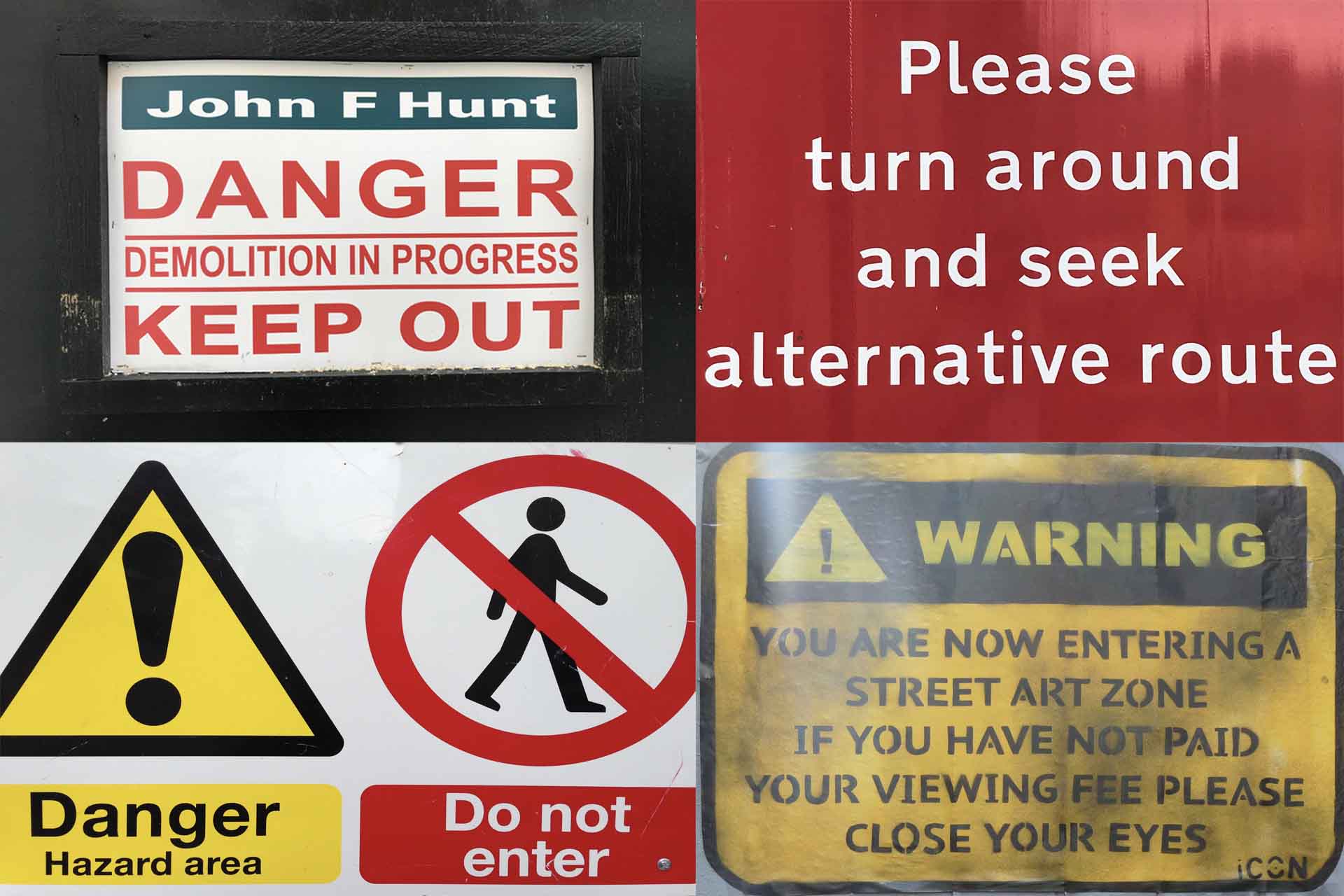The forgotten project communication
Project communication and the information interest of stakeholders
There are very many different project types and approaches in projects. A software development project differs from a software implementation project, a construction project from a relocation project, a website project from an ISO certification project. In the vast majority of projects, communication is a key success factor, but one aspect is often neglected: external project communication. With the information interest of all stakeholders – i.e. all persons or organisations that are directly or indirectly affected by or have an interest in the activities of an organisation – in view, the understanding of projects, activities, decisions increases. And everyone wins.
An example of a missing project communication: The construction site in front of the door!
The communication in a project, the definition of goals and procedures, the initial and continuous exchange between the project participants, between superiors and individual employees, within the team, between teams or between superiors – all these points are important for the success of a project. But here I would like to describe a different perspective on a project, the perspective of an outsider. And as an example, a construction site on my doorstep.

The construction site in front of the door.
It’s a normal construction site. Heavy machines arrive, the sidewalk is torn open by construction workers, something is done, someone feels like telling half a day of his life story and entertains his colleagues. Or should it say: he keeps his colleagues away from work? I do not know what they are talking about, so I cannot be a judge. There are, however, a few points on which I would like to form an opinion:
- Why is there a construction site?
- What is being worked on and what is to be achieved?
- When does it really start and when is the goal reached?
In short: What do I get in the end from the construction site?
My external need for knowledge
I was in London recently and over 200 new skyscrapers are to be built there over the next 10 years. The construction boom has long since spread to the metropolis, but I, as a passer-by, have not noticed any significant impairments. From time to time I had to change the side of the street, but that was all. Often, I was also happy about the unusual information signs that could also hang in a museum as Pop Art:

Construction site meets Pop Art.
Honestly, most construction sites don’t interest me. They have no relevance to me. If I am standing on a motorway and read a sign “We are building for you until April 2019”, I am aware that this sign – even if there is nothing substantial on it besides a deadline – calms many motorists. A reason, no matter how superficial and lacking in content, is still better than none. It informs, awakens understanding and empathy. It’s nice that the section is being extended for me as a car driver.
So why am I interested in this construction site? Well, the reason is simple. It lies in front of my door. I see it every day. It does influence my route a little and parking in front of the door is also restricted, but I can live with it just as well as with any other construction site. The main difference for me is one level deeper: what influence does the construction site have on me and my work?
This question is important to me. Do I have to expect restrictions? How long will there be restrictions? Will they be sporadic or permanent? I’m not asking myself why I can’t work on the project – I might ask myself this question if I had a project in my professional environment that I would like to work on and/or could contribute something useful.
Absence of project communication leads to speculation
“Electricity.” That was the answer of a construction worker to the question of an acquaintance, why the construction site existed. “Electricity.” What do you do with such an answer? Surprisingly, we have electricity in the building. Every day. 24 hours. Around the clock. Works great. Comes out of the socket. No neighbour can remember power outages in the building. Perhaps consumption has increased in recent years? Maybe power cables need to be replaced after a certain period of time? Maybe additional cables need to be laid? I can only speculate. And not only about the bottom of the building site, but also about practically everything else:
- Why is the construction site referred to with a start date, but then only 2 weeks later with the first cut of the spade begun?
- Can the time lost at the beginning be made up?
- How long should the construction site last? (The statement “end of May” was probably a little joke from a construction worker.)
- Why is there only sporadic work on the site? Are there more important construction sites or missing materials?
- Why do only a few of the workers really work – if there are several construction workers on site? Is this a social loafing phenomenon?
- Why doesn’t it seem possible to tackle several activities in different places at the same time?
- Is there an incentive for construction workers to quickly get to grips with their jobs?
- Do construction workers actually get feedback?
Of course, the list can be continued at will. In fact, I have no answers to most questions and the construction site remains a little mystery. But: I can learn something from the construction site. For my project communication with colleagues.
Situational and institutional project communication
“It’s too complicated to explain.”
Or “Well, you know we’re working on the next release.”
Do you know such answers from colleagues when you ask them in the coffee kitchen what they are working on?
Perhaps the coffee kitchen is not a suitable place for such conversations, perhaps the colleague has little time at the moment. It is clear, however, that an unanswered question cannot produce anything positive. How long can it take to answer the question with “I am currently working on a great glossary of many terms from software development and project management” or “I am currently doing a code review for XY? XY works with a nearshoring partner and they want an independent third party to assess how good the architecture and code really are.” Not long, is it?
Situational project communication among colleagues can be very easy. It promotes mutual understanding, feedback or ideas. Of course, there are limits to such situational communication:
- Communication often takes place between two people, so the exchange of knowledge is limited.
- Project communication itself is based on chance, because dialogue only takes place when two people meet by chance in the coffee kitchen or on the way to lunch.
- The communication only reflects a personal part of the project or the development.
- The projekt communication is based on personal sympathy, because only those who are almost sympathetic will engage in such an exchange.
In principle, situational project communication is good, but at best it can complement institutional communication. Institutional project communication has a greater reach. It addresses teams, departments or corporate divisions. It can
- describe projects with their objectives, scope, duration, techniques used and the expected benefits for stakeholders.
- in the sense of an agile organisation, provide the basis for project markets and thus for the participation and involvement of employees.
- regularly discuss progress, challenges and learnings.
- positively influence the internal image of the organisation.
- form the basis for an exchange at eye level.
- present results.
Obviously, institutional project communication makes a lot of sense. Unfortunately, there are still numerous companies today that forget this communication. Perhaps it will not be forgotten, but only avoided? Perhaps you also know companies where turnover figures or losses, fluctuation, difficulties with developments, critical feedback from customers are simply not communicated? Is this supposed to be a kind of protection for employees? Is there any uncertainty about the form of information transfer? Of course, companies should think about the type, frequency and documentation of the information, but the vast majority of employees are of age. If information is not communicated institutionally, communication is often situational. And this often leads to speculation again.
Conclusion
“What do I get from the construction site?” Translated into everyday working life, this is the question that occupies many employees. What relevance does a project, a development have for me? Could it be that a colleague has to help out in another project at short notice, so that I have to do more work? Why can a colleague participate and not me? Why do we develop A and not B? Is it possible to benefit from the results of other teams?
The personal relationship is often essential, whether it is at a construction site on the doorstep or in a development project for a customer. If there is simply no reference, a short piece of information is usually sufficient. Organisations should not forget or avoid this project communication. If an organisation keeps the information interest of all employees in mind, the exchange among each other increases. The sense of unity and motivation increase. And everyone wins.
Notes:
Michael Schenkel has published more articles in the t2informatik Blog, for example

Michael Schenkel
Head of Marketing, t2informatik GmbH
Michael Schenkel has a heart for marketing - so it is fitting that he is responsible for marketing at t2informatik. He likes to blog, likes a change of perspective and tries to offer useful information - e.g. here in the blog - at a time when there is a lot of talk about people's decreasing attention span. If you feel like it, arrange to meet him for a coffee and a piece of cake; he will certainly look forward to it!
In the t2informatik Blog, we publish articles for people in organisations. For these people, we develop and modernise software. Pragmatic. ✔️ Personal. ✔️ Professional. ✔️ Click here to find out more.


